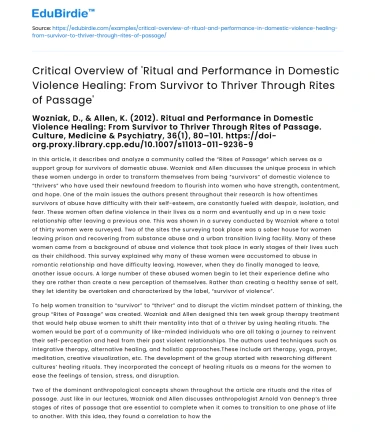Wozniak, D., & Allen, K. (2012). Ritual and Performance in Domestic Violence Healing: From Survivor to Thriver Through Rites of Passage. Culture, Medicine & Psychiatry, 36(1), 80–101. https://doi-org.proxy.library.cpp.edu/10.1007/s11013-011-9236-9
In this article, it describes and analyze a community called the “Rites of Passage” which serves as a support group for survivors of domestic abuse. Wozniak and Allen discusses the unique process in which these women undergo in order to transform themselves from being “survivors” of domestic violence to “thrivers” who have used their newfound freedom to flourish into women who have strength, contentment, and hope. One of the main issues the authors present throughout their research is how oftentimes survivors of abuse have difficulty with their self-esteem, are constantly fueled with despair, isolation, and fear. These women often define violence in their lives as a norm and eventually end up in a new toxic relationship after leaving a previous one. This was shown in a survey conducted by Wozniak where a total of thirty women were surveyed. Two of the sites the surveying took place was a sober house for women leaving prison and recovering from substance abuse and a urban transition living facility. Many of these women came from a background of abuse and violence that took place in early stages of their lives such as their childhood. This survey explained why many of these women were accustomed to abuse in romantic relationship and have difficulty leaving. However, when they do finally managed to leave, another issue occurs. A large number of these abused women begin to let their experience define who they are rather than create a new perception of themselves. Rather than creating a healthy sense of self, they let identity be overtaken and characterized by the label, “survivor of violence”.
To help women transition to “survivor” to “thriver” and to disrupt the victim mindset pattern of thinking, the group “Rites of Passage” was created. Wozniak and Allen designed this ten week group therapy treatment that would help abuse women to shift their mentality into that of a thriver by using healing rituals. The women would be part of a community of like-minded individuals who are all taking a journey to reinvent their self-perception and heal from their past violent relationships. The authors used techniques such as integrative therapy, alternative healing, and holistic approaches.These include art therapy, yoga, prayer, meditation, creative visualization, etc. The development of the group started with researching different cultures’ healing rituals. They incorporated the concept of healing rituals as a means for the women to ease the feelings of tension, stress, and disruption.
Save your time!
We can take care of your essay
- Proper editing and formatting
- Free revision, title page, and bibliography
- Flexible prices and money-back guarantee
Two of the dominant anthropological concepts shown throughout the article are rituals and the rites of passage. Just like in our lectures, Wozniak and Allen discusses anthropologist Arnold Van Gennep’s three stages of rites of passage that are essential to complete when it comes to transition to one phase of life to another. With this idea, they found a correlation to how the stages of healing are parallel to the rites of passage. The first stage is the rites of separation in which our lectures refer to it as the step taken when removing oneself from society. During this process, a person is destroying their old “self”. They are seperating from their past way of life to start a new one. Similarly, during the stages of healing for the group “Rites of Passage”, the abused women are separating from their old life by leaving a battered relationship. The second stage, rite of transition, is when participants enter a liminal phase. According to the authors, this is the most crucial stage to healing for the women. Interestingly, in Moro’s text from the article Betwixt and Between: The Liminal Period in Rites de Passage, anthropologist, Victor Turner, describes this phase is where participants are considered symbolically invisible and in a state of ambiguity (92). He also stresses that during the is phase it is imperative to develop emotional bonds with individuals who are going through the same journey. This is shown in the article where the women are performing healing rituals together. These rituals often incorporate practices of salvation and revitalization rituals. They may also include group activities that combine protective and intensification elements. Example of such are art therapy, yoga, creative visualization, and so forth. The creation of healing rituals in this group are either borrowed from different cultures and modified or spontaneously created. However once it is created, the rituals are adapted into a repetitive routine. Again, this ties back to our lecture of a ritual characteristics and support the idea how many of these rituals signify the central values and beliefs of a group. The purpose these healing rituals serve to these women are that they provide a self-care, a sense of unity, experience calmness and peace, and improvement of self. The last stage is the rites of incorporation which is referred “ritual of rebirth” in the article. In this stage, the women have achieved the role of a “thriver”. They have emerged from their transition to someone who has overcome their past with the proper healing and support. According to Gennep, this stage is where the subjects emerges from his or her journey with new identity and purpose. They have integrated back into society as a person who has grown spiritually and a new status among their peers. In the group, women who have achieved this stage are finally able to move forward with their lives and not let their past control how they perceive themselves.






 Stuck on your essay?
Stuck on your essay?

